Monowar Bhuyan
Unmasking Backdoors: An Explainable Defense via Gradient-Attention Anomaly Scoring for Pre-trained Language Models
Oct 05, 2025Abstract:Pre-trained language models have achieved remarkable success across a wide range of natural language processing (NLP) tasks, particularly when fine-tuned on large, domain-relevant datasets. However, they remain vulnerable to backdoor attacks, where adversaries embed malicious behaviors using trigger patterns in the training data. These triggers remain dormant during normal usage, but, when activated, can cause targeted misclassifications. In this work, we investigate the internal behavior of backdoored pre-trained encoder-based language models, focusing on the consistent shift in attention and gradient attribution when processing poisoned inputs; where the trigger token dominates both attention and gradient signals, overriding the surrounding context. We propose an inference-time defense that constructs anomaly scores by combining token-level attention and gradient information. Extensive experiments on text classification tasks across diverse backdoor attack scenarios demonstrate that our method significantly reduces attack success rates compared to existing baselines. Furthermore, we provide an interpretability-driven analysis of the scoring mechanism, shedding light on trigger localization and the robustness of the proposed defense.
Federated Learning for Large-Scale Cloud Robotic Manipulation: Opportunities and Challenges
Jul 23, 2025Abstract:Federated Learning (FL) is an emerging distributed machine learning paradigm, where the collaborative training of a model involves dynamic participation of devices to achieve broad objectives. In contrast, classical machine learning (ML) typically requires data to be located on-premises for training, whereas FL leverages numerous user devices to train a shared global model without the need to share private data. Current robotic manipulation tasks are constrained by the individual capabilities and speed of robots due to limited low-latency computing resources. Consequently, the concept of cloud robotics has emerged, allowing robotic applications to harness the flexibility and reliability of computing resources, effectively alleviating their computational demands across the cloud-edge continuum. Undoubtedly, within this distributed computing context, as exemplified in cloud robotic manipulation scenarios, FL offers manifold advantages while also presenting several challenges and opportunities. In this paper, we present fundamental concepts of FL and their connection to cloud robotic manipulation. Additionally, we envision the opportunities and challenges associated with realizing efficient and reliable cloud robotic manipulation at scale through FL, where researchers adopt to design and verify FL models in either centralized or decentralized settings.
The Efficiency of Pre-training with Objective Masking in Pseudo Labeling for Semi-Supervised Text Classification
May 10, 2025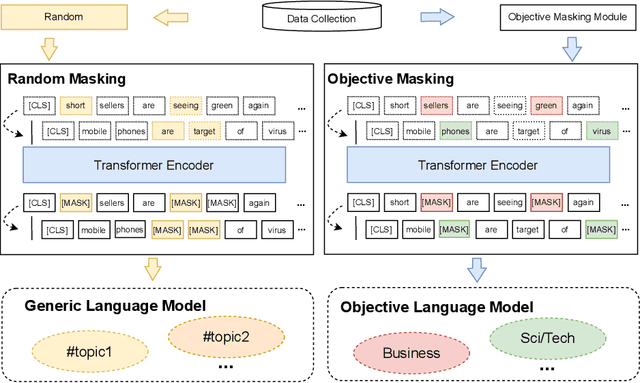

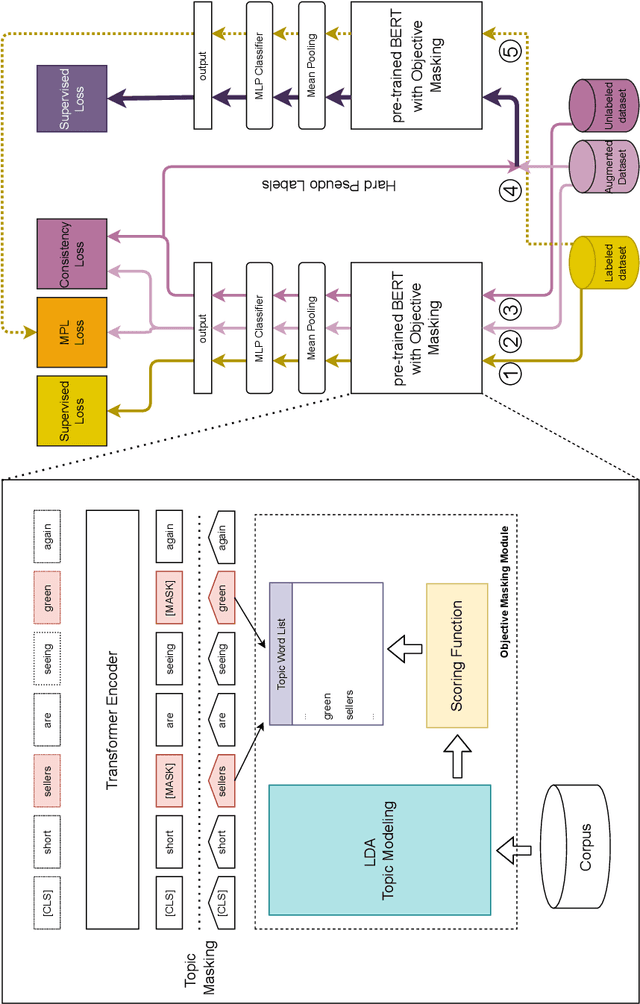

Abstract:We extend and study a semi-supervised model for text classification proposed earlier by Hatefi et al. for classification tasks in which document classes are described by a small number of gold-labeled examples, while the majority of training examples is unlabeled. The model leverages the teacher-student architecture of Meta Pseudo Labels in which a ''teacher'' generates labels for originally unlabeled training data to train the ''student'' and updates its own model iteratively based on the performance of the student on the gold-labeled portion of the data. We extend the original model of Hatefi et al. by an unsupervised pre-training phase based on objective masking, and conduct in-depth performance evaluations of the original model, our extension, and various independent baselines. Experiments are performed using three different datasets in two different languages (English and Swedish).
Adaptive Deviation Learning for Visual Anomaly Detection with Data Contamination
Nov 14, 2024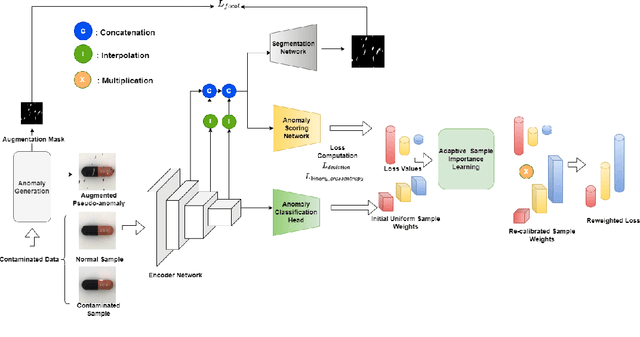


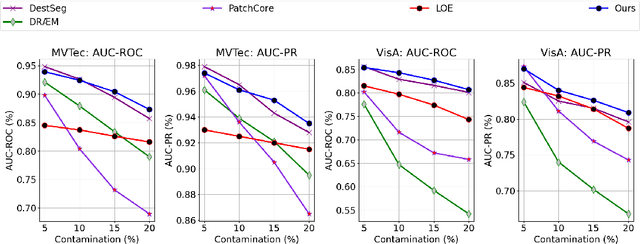
Abstract:Visual anomaly detection targets to detect images that notably differ from normal pattern, and it has found extensive application in identifying defective parts within the manufacturing industry. These anomaly detection paradigms predominantly focus on training detection models using only clean, unlabeled normal samples, assuming an absence of contamination; a condition often unmet in real-world scenarios. The performance of these methods significantly depends on the quality of the data and usually decreases when exposed to noise. We introduce a systematic adaptive method that employs deviation learning to compute anomaly scores end-to-end while addressing data contamination by assigning relative importance to the weights of individual instances. In this approach, the anomaly scores for normal instances are designed to approximate scalar scores obtained from the known prior distribution. Meanwhile, anomaly scores for anomaly examples are adjusted to exhibit statistically significant deviations from these reference scores. Our approach incorporates a constrained optimization problem within the deviation learning framework to update instance weights, resolving this problem for each mini-batch. Comprehensive experiments on the MVTec and VisA benchmark datasets indicate that our proposed method surpasses competing techniques and exhibits both stability and robustness in the presence of data contamination.
Personalized Multi-tier Federated Learning
Jul 19, 2024
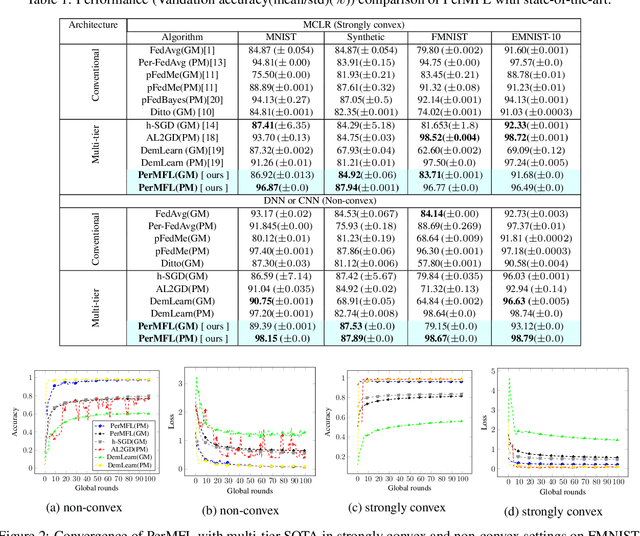

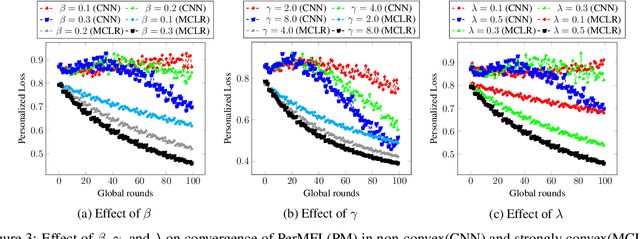
Abstract:The key challenge of personalized federated learning (PerFL) is to capture the statistical heterogeneity properties of data with inexpensive communications and gain customized performance for participating devices. To address these, we introduced personalized federated learning in multi-tier architecture (PerMFL) to obtain optimized and personalized local models when there are known team structures across devices. We provide theoretical guarantees of PerMFL, which offers linear convergence rates for smooth strongly convex problems and sub-linear convergence rates for smooth non-convex problems. We conduct numerical experiments demonstrating the robust empirical performance of PerMFL, outperforming the state-of-the-art in multiple personalized federated learning tasks.
Few-shot Anomaly Detection in Text with Deviation Learning
Aug 22, 2023Abstract:Most current methods for detecting anomalies in text concentrate on constructing models solely relying on unlabeled data. These models operate on the presumption that no labeled anomalous examples are available, which prevents them from utilizing prior knowledge of anomalies that are typically present in small numbers in many real-world applications. Furthermore, these models prioritize learning feature embeddings rather than optimizing anomaly scores directly, which could lead to suboptimal anomaly scoring and inefficient use of data during the learning process. In this paper, we introduce FATE, a deep few-shot learning-based framework that leverages limited anomaly examples and learns anomaly scores explicitly in an end-to-end method using deviation learning. In this approach, the anomaly scores of normal examples are adjusted to closely resemble reference scores obtained from a prior distribution. Conversely, anomaly samples are forced to have anomalous scores that considerably deviate from the reference score in the upper tail of the prior. Additionally, our model is optimized to learn the distinct behavior of anomalies by utilizing a multi-head self-attention layer and multiple instance learning approaches. Comprehensive experiments on several benchmark datasets demonstrate that our proposed approach attains a new level of state-of-the-art performance.
 Add to Chrome
Add to Chrome Add to Firefox
Add to Firefox Add to Edge
Add to Edge